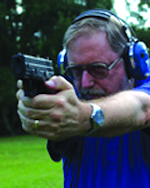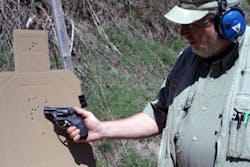A couple of months back, in my column about new products from the 2009 SHOT Show, I reported that I had the opportunity to test fire the new Ruger revolver, the LCR, at the Media Day event. LCR in this case stands for Lightweight Compact Revolver and it follows on the heels of the Ruger LCP (Lightweight Compact Pistol) that was all the rage at the 2008 SHOT Show. I was initially impressed with the LCR, but actual hands-on time at the range in Orlando was limited by the circumstances and the need to share with others. Since that time I have been waiting for a chance to spend some serious testing and evaluation time with the LCR, just to see if my initial impressions would hold up. The opportunity finally arrived last week, when my colleague Massad Ayoob brought an LCR by the gun shop during our annual open house. It was the first one we had all to ourselves, so after playing show and tell all day at the shop, I was anxious to get some trigger time with it on our range.
Before I get to that, I suppose I should briefly review what the LCR has to offer, so any testing can be kept in proper perspective. The LCR, as the name implies, is a small, 5 shot, .38 Special snubby revolver, that should be able to fulfill all the roles we have come to expect from such revolvers in a law enforcement or personal protection setting. Certainly, small revolvers of all brands have earned their stripes many times over, so what is so revolutionary about this one? Well, probably the biggest thing is that Ruger has chosen to use what they call "Long Strand, Glass-Fiber Filled Polymer" for a significant portion of the frame. Specifically, the parts of the frame that house the firing mechanism and the grip are polymer, which is responsible for a good bit of the "Lightweight" part of the name. This polymer technology, combined with an aircraft grade aluminum housing surrounding the cylinder and the exterior of the barrel, along with a stainless steel cylinder and barrel liner, allows the LCR to weigh in at 13.5 ounces and still be tough in all the right places. That alone makes the LCR revolutionary, in my book. But there is more.
The cylinder has unusual looking, deeply fluted, rounded chambers and has an "Advanced Target Grey" finish, that not only looks good but seems to have a "slickness" to the surface that minimizes powder residue accumulation and surface marring. The other thing that impressed us immediately when we got to shoot the test gun in Orlando was that the trigger is not what we have come to expect from a Ruger. Please understand, Ruger has made excellent quality revolvers for decades, including ones with short barrels, such as the SP101. But Rugers have always been synonymous with rugged, almost overbuilt workhorses that have a long and somewhat heavy trigger pull. The trigger mechanism in this new Ruger, however, has a whole new feel. Ruger engineer Joe Zajk, the man behind the new trigger design, explained it all, including showing us all the internal parts, during the melee that was the Media Day. The simple explanation is that the trigger components have been completely redesigned, employing a new operating cam mechanism that is not like anything in any other revolver. It has a smooth, non-stacking pull that breaks cleanly and measures a reasonably light ten pounds on our Lyman trigger pull gauge. So, the LCR is lightweight, looks sort of "space age" and has a really great trigger. How does it shoot?
One other thing that impressed me when I shot the LCR in Orlando was that the recoil seemed very mild for such a light gun. Before I did anything else at the range, I wanted to see if that was still the case using .38 Special +P loads. My first cylinder was loaded with the Speer Gold Dot 135 grain +P Hollow Point ammo, which is specifically designed for short barreled revolvers. It is the load I would anticipate carrying in the LCR for serious defensive purposes. I chose a distance of four yards for the first test firing, since I would generally expect to use a snubby for close-in work. The results yielded a head shot group that measured one and one half inches overall for all five shots, with the best three in three-quarters of an inch. I use the "best three" as a measure of the gun's potential inherent accuracy, finding that doing so usually factors out any poor shooting on my part.
In firing those five rounds, two other things came immediately to mind. First, the LCR comes equipped standard with Hogue ® Tamer ™ grips (it will also be available with Crimson Trace Lasergrips ® as an option), and the recoil with those grips is very mild for so light a gun. This was just as I had remembered from Orlando, but my shooting here was with a hot +P load; so far so good. The second thing that I noticed was that I could actually see a decent sight picture as I lined the LCR up on the target. Snubbys usually have very rudimentary sights, amounting to little more than a bump on the front of the barrel and a groove on the top of the frame. The LCR has a decent sized, deeply serrated front sight blade and the frame has a broad groove with sharply defined edges. This allows for plenty of light on either side of the front sight picture, so your eyes can see that the front sight is properly centered and level in the notch. In other words, I think you can actually use the sights to hit something at more than "belly gun" distances.
To test that theory, I moved back to ten yards and fired five rounds of standard velocity MagTech .38 FMJs at the chest of the target. It was not as satisfying a result! That group opened up to well over five inches, looked more like a pattern than a group, and one round showed the beginnings of key-holing. I marked those five and switched back to a hotter load, this time the Speer Lawman 158 grain +P FMJ round. What a difference! That five shot group, still at ten yards, measured one and seven-eights inches, with the best three again measuring only three-quarters of an inch. Apparently this particular gun favors the hotter ammo.
Feeling a bit confident with the clear sight picture, I moved back to the twenty five yard bench rest table. Using a two hand hold, supported by a MTM® Case-Gard™ pistol rest, I fired another five rounds of the Speer GDHP 135 grain +Ps. The overall group measured five and one-quarter inches, but the best four were within an inch and seven-eights and the best three were in one and five-eights of an inch. I also had a three and one-quarter inch group with the Speer Lawman, with the best three in one and one-sixteenth of an inch. In reviewing these results, as well as some other groups shot by Mas Ayoob, we realized two things about this particular gun. One was a tendency to throw one "flyer" out of each group. These were not called flyers, meaning we felt them go awry because of something we did, but rather they went astray on their own. Mas thought it may have been from one chamber in particular, but my shooting did not confirm that, so we weren't exactly sure why it was happening. The other thing was the tendency of some rounds to key-hole, which is caused by the bullet starting to destabilize and yaw or tumble. It was happening mostly with either standard velocity rounds or with all-lead bullets. Mas had fired some Black Hills 148 grain wadcutters and some Remington 158 grain +P lead semi-wadcutter hollow points, normally a superb load, and found that this LCP did not perform well with them. I had the same results with the Black Hills ammo. Unfortunately, we don't have another LCR available to see if this is just this one gun or something that may be design related. For now, I'm pleased with the +P Speer GDHP, which is what I would be using anyway.
Overall, I really like this gun. It has all the attributes of a lightweight snubby, but none of the usual faults. It has good, useable sights, recoil is manageable, even with hot loads and it is accurate at normal snubby shooting distances. It has a smooth, crisp and reasonably light trigger, right out of the box. The LCR is as light as a Smith and Wesson 340 M&P, but has a much lighter price tag at $525 suggested retail, compared to a list price of $948 for the S&W. With the Crimson Trace Lasergrips ® it lists for $792 versus $1232 for the Smith. It should be just the ticket as a back-up gun in a pocket, vest or ankle holster. The only thing now is waiting for it to be available at your local gun shop. Ruger says that they began shipping the LCRs in mid March, but due to the overwhelming demand for the LCR - availability will be limited. Ruger also says it is one of the most significant new revolver designs in over a century. I agree!

Steve Denney
Steve Denney is a former municipal police sergeant, USAF Officer and chief of security/safety officer for a large retirement and healthcare community. A former SWAT officer, crime prevention officer and both military and police firearms trainer, he is currently an instructor for LFI Judicious Use of Deadly Force, LFI Stressfire, and NRA and other defensive tactics disciplines. He currently trains police, military and private citizens. He is a charter member of ILEETA and a member of IALEFI.



